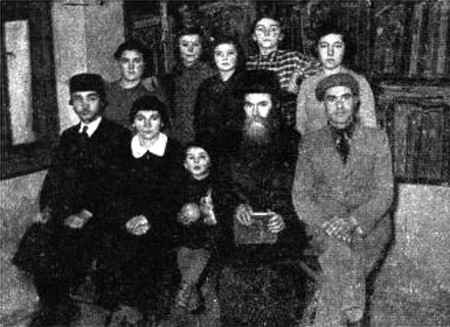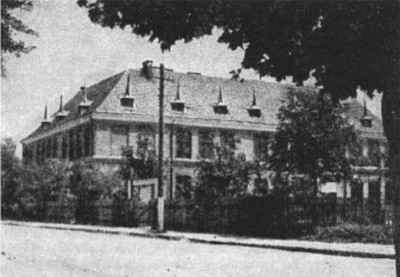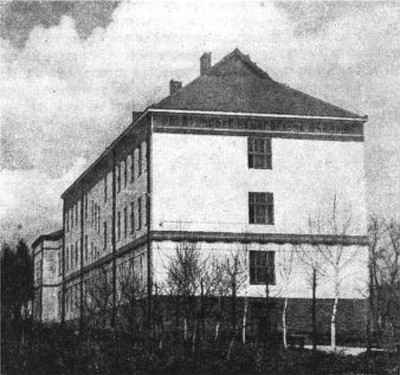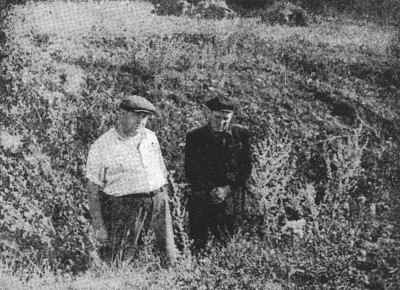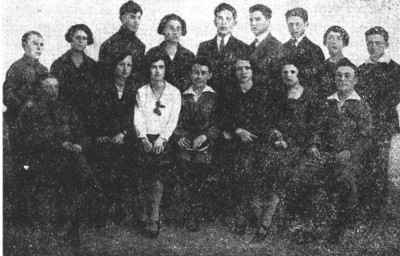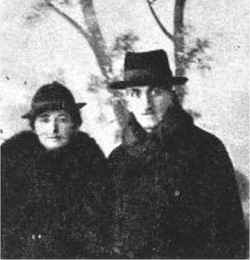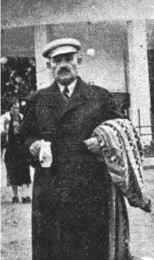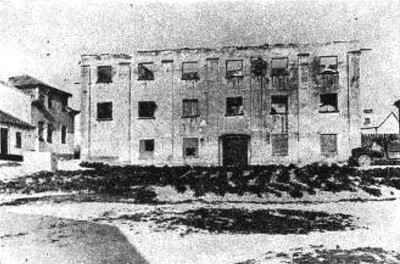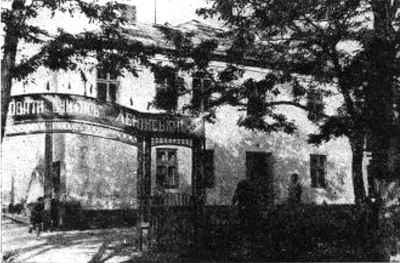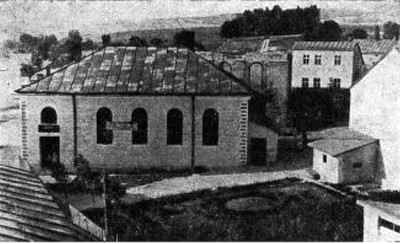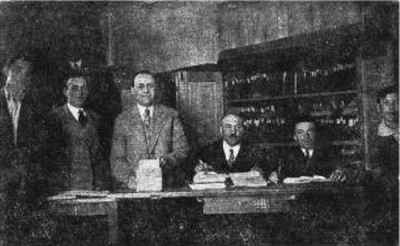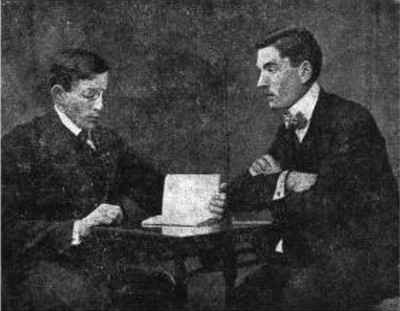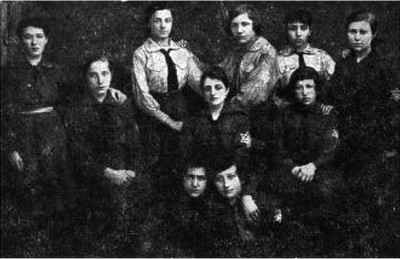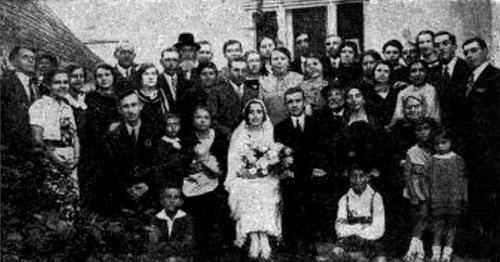[Pages 8485]
Life of the City
Rohatyn
by Rabbi Yitzchak Weisblum, Haifa
Translated by Rabbi Mordecai Goldzweig
Rohatyn is one of the small towns of Galicia that do not usually appear on a
world map but left their lasting impression on the Jewish map of Galicia in the
hearts of Torah, Judaism, and Hasidism. It is not the size of an area that
brings about important decisions but the amount of influence that a place
exerts and the distinguished personalities who live within it and honor it with
their presence. This applies to Rohatyn. It earned its fame through the great
people who lived in it. One of the most outstanding of these was the holy Gaon,
Rabbi David Moshe Avraham, the son of Reb Tzadok Ashkenazi, of blessed memory,
the dayan (chief justice) of Rohatyn and the author of Mirkevet Hamishne, who passed away in Rohatyn on 18 Heshvan 5510. According to tradition, he
used to be visited by the Baal-Shem-Tov, of blessed memory, and even received
his blessing.
It was a privilege and an honor for a rabbi to live in a place where his
predecessors were great men. Such greatness was a drawing factor in attracting
rabbis who chose this place over a larger one. Rohatyn was a town that excelled
over others because of its great rabbis and dayanim. The last of those who presided over the religious court was our teacher and
rabbi, Avraham David Spiegel, of blessed memory (may his blood be avenged by
the Alm-ty), who was murdered by the butchers (may their names be erased).
Rabbi Avraham David Spiegel was a native of the town of Rohatyn, born in 5645
(1885), a descendent of the Gaon, Rabbi Avraham David Moshe, the author of the Mirkevet Hamishne, who blended within his personality a wide variety of superior qualities. As a
chief justice, he was strong and strict on one hand and meek and gentle on the
other. A great man in Torah, it automatically follows that he possessed wide
understanding and comprehension, a strong feeling of pity for others, as well
as a pleasant demeanor towards people. He was ordained as a rabbi in his youth
by the greatest rabbis of the day in Galicia. This included the Gaon, the
Marsham of Brzezany (Moreinu Rabbi Shalom Mordechai Hacohen Schwadron), a
famous posek (rabbinical religious authority) of his day, of blessed memory, and the Gaon,
Rabbi Meir Arik, of blessed memory, chief dayan of Tarnσw, as well as other rabbis. The extent of his greatness may be
judged by the Shelot U'Tshuvot (responsa) he exchanged with the great rabbis of the day. These included Rabbi
David Halevi Horowitz, of blessed memory, chief rabbi of Stanislawow, who
recorded his questions together with his response, indicating that he was
communicating with an important rabbi.[*] Because of his greatness and the charm of his personality, he served as Av Beth Din (chief justice of the rabbinical court) of Rohatyn for over thirty years, as
well as many additional years as acting chief justice, until Rabbi Mordechai
Lippe Teumim, of blessed memory, was officially accepted as chief justice, may
his blood be avenged.
The Hasidism of Stratyn that established its residence in Rohatyn through the Admor, our teacher and rabbi, Rabbi Uri, of blessed memory, the son-in-law of the
Holy Admor, Rabbi Avramtche of Stratyn, of blessed memory, placed its stamp on the people
of the area. This approach of forgiveness and simplicity was also the way of
the great Rabbi Spiegel, of blessed memory, who gave up his position in favor
of Rav Teumim, even though he could easily have continued as acting rabbi and
prevented the acceptance of anyone else. This action, reflecting his noble
personality and meekness, renders him as a true heir of the B'nei Beteira (the
sons of Beteira Shmaya and Avtalyon) who gave up their presidency of the
Sanhedrin to Hillel Hazaken. Rabbi Yehuda Hanassi said about him, “There
were three who personified meekness, my father (Rabbi Shimon ben Gamliel), the
sons of Beteira, and Jonathan, the son of Shaul (Bava Metzia Chap. 5). (It was
written at the end of Tractate Sota of the Jerusalem Talmud about Rabbi Yehuda Hanassi, that when he passed away “there came to an
end meekness and the fear of sin in the world.”) Where his greatness lay,
there was his meekness. This memory of Rabbi Avraham David Spiegel is engraved
in the hearts of all of the people of Rohatyn as one who shaped the character
of the town and the living spirit that existed within it that was lost when the
town was lost, thereby closing the grave of this elevated community. May they
rest in peace.
|
|
This picture was taken January, 1938 in the courtroom of Rabbi Spiegel,
of blessed memory, also showing his library
First row, standing to the right:
Chayche, Yente, Reizel, Chana-Taube, Yuta, Yehoshua, Rabbi Avraham David
Spiegel, Ryfke, Rebbetzin Chaya, and Yaakov Meshulam. Rabbi Spiegel is shown
holding Yalkut Shimoni, the book he constantly studied |
[Pages 86100]
The Rohatyn Way
by Dr. Isaac Lewenter, New York
Translated by Benyamin Weiner
1
Rohatyn was actually once a little shtetl. Back in the Polish days, letters
were addressed to us as follows: “Rohatyn by Firlejow.” Jews called
it Perlev. Later, Firlejow became one of the villages surrounding Rohatyn.
Rohatyn stood at a crossroads that went on in one direction toward Lemberg and
Stanislawow, and, in the other direction, toward Tarnopol and Stryj. This
facilitated the development of trade and transport in our shtetl. When they
built the train station in Rohatyn, it became a passage point between Tarnopol
and Stryj.
Jewish life in Rohatyn dates almost from the earliest years of Polish history.
Jews lived in Rohatyn for over nine hundred years. In the old cemeteries, one
could find gravestones seven to nine hundred years old. Rohatyn was also
associated in Jewish history with a number of its inhabitants who were
followers of the Shabbethai Zevi movement (hence we were called by the nickname
“Shabbetzvinikes”) and Frankists.
These are my words of introduction to the actual description I will offer of
Jewish Rohatyn prior to the destruction of the Third Temple. I will use no
historical material in my exposition of this topic. These will be personal memories.
2
Rohatyn was considered a “Jewish city.” Close to four thousand Jews
lived there. In the time of World War II, around ten thousand Jewish souls
thronged together in Rohatyn as people fled Hitler's advancing soldiers. Of
this number, very few survived. Nearly the entire Jewish community of Rohatyn
was murdered by the Germans and their local assistants, the Poles and the
Ukrainians.
Prior to World War I, life in Rohatyn, from a Jewish standpoint, was quite
interesting. A Zionist movement was organized very early on, and many of its
leaders became known, not just within our shtetl but also outside its borders
(Shalom Melzer and Sender Margolis among others). We had many Hasidim, as well,
who did not constitute an anti-Zionist force but were simply honest and
faithful followers of the Rebbe.
The hall of the Zionist league was a gathering place for older and younger
Zionists alike. There, we spent long hours “politicking,” playing
chess, and participating in a host of other activities. I had the pleasure of
defeating the old chess players, Avrum Zlatkis and Yaakov Fish.
3
I remember the rabbi of Rohatyn (and later Rzeszow) well Rabbi Natan
Lewin. He was a learned Jew with a fine, stately beard. He was esteemed and
highly thought of by all. When he walked in the street, he was met with great
respect. His face shone with such a special light that not just Jews but
Christians, too, would give way as he passed. His sermons, full of Jewish and
worldly knowledge, were renowned. It was said that people did not walk to his
sermons, they ran to them. He gave them every Shabbos “after table.”
On the birthday of the Kaiser and other state holidays, the rabbi would deliver
his witty, German “speeches” that would astound the fancy-dressed
local officials in attendance and fill them with wonder at the rabbi's
oratorical skill.
When I was still a little child, my grandfather used to take me with him to the
rabbi's table. I would listen carefully to his clever words about Torah,
without understanding a thing
As I remember, the rabbi did not stay long in our city because Rohatyn was too
poor to support his family. After his departure, the city remained without a
rabbi for a long time. Meanwhile, the office was occupied by the dayan (judge), Reb Kave Schein, a man entirely the opposite of the rabbi. Whereas
the rabbi was steeped in Jewish and worldly knowledge, and on top of that a
handsome man who commanded the attention of everyone he met, Reb Kawe was an
introverted man, small in stature, having only the one-sided knowledge of
Jewish religious practices and laws. He was, however, honesty and piety
personified. For this reason, he was held in high esteem.
In his old age, the dayan no longer had the strength to carry out his duties, and in 1904, his place was
taken by Rabbi Meir Henge from Strzeliska. Rabbi Henge was an old-fashioned
Jew, with all of the attendant virtues. He knew how to study
and was esteemed for his piety and kindness.
After a time, a “local boy” from Rohatyn was chosen to serve as dayan. This was the “young dayan,” Reb Avrum-Dovid Spiegel, whose family was well known in Rohatyn. His
brother, Neftali, returned from America and struggled bitterly his entire life
to make a living. He was popular in the shtetl because of the wonderful cloth
work he used to do for the gymnasium (high school), embroidering curtains for
the holy ark and decorative mantles for the Torah scrolls. Generally, he was an
expert in piecework. The second brother, Pinchas, was a clever and handsome
man, a devoted Zionist, and my good friend. He also eked out his existence
bitterly until the final years.
Even though Reb Avrum-Dovid Spiegel was a “local boy” from Rohatyn
itself, the administration of the community did not provide for his livelihood.
When his children grew up, they were obliged to provide for themselves. One of
his children, Yehoshua, now lives in the state of Israel, and, as I understand
it, the yoke of putting together our Yizkor book lies mainly on his shoulders.
4
Rohatyn was generally regarded by inhabitants and outsiders alike as a
progressive town. It contained two middle schools (gymnasium) one,
Ukrainian, and the other, Polish. Many Jewish children studied in these
schools. In Austrian times, no educational restrictions were placed on Jewish
children. These were first instituted when Poland achieved independence.
The Ukrainian gymnasium, a private school, was founded in 1907, and the Polish
(state) school, in 1912. Most Jewish children went to the Polish school,
although the instruction there was useless. It was maintained by the civil
authorities. There were also some Jewish boys and girls who attended the
Ukrainian gymnasium.
Most of the Jewish population of Rohatyn made their living in small trade. They
bought eggs, butter, cheese, chickens, geese, and ducks from the local farmers
and sold them to other Jews. A fair was held every Wednesday.
In our shtetl, there were a few merchants with bigger trade. They would bring
their goods from Lemberg, Stanislawow, Vienna, and Budapest. These were the
shtetl magnates, the gentry, who dealt with rich Jews and local landowners.
There was also, as in every other Polish-Jewish shtetl, a significant class of
Jewish craftsmen shoemakers, tailors, carpenters and the like. The
shtetl also possessed a few Jewish clerks, a small number of lawyers, three
Jewish doctors (Dr. Stein, Dr. Schaff, and Dr. Mehlman) and a few Jewish
schoolmistresses. I must also mention the local religious teacher, the tiny
Schwartz (we used to call him “Schwartzenyu”). He had one outstanding
quality; he did not teach too much to the children, simply because he did not
know very much himself. No child ever received a “two” in religion
from him, and therefore no child ever needed to be held back for a second year
in the same class.
Jewish children also studied Hebrew. This subject was taught in two places
the cheder (Jewish elementary school) and the Hebrew school. In cheder, the youngest children started off with the “children's teacher.” As
they grew, they advanced to the study of Chumash and ” Chumash with Rashi” until they worked their way up to the study of ” Gemara with Tosafos” and Tanach.
5
Such was the path I took. My “children's teacher” was Rabbi Hirsh
Fang. Baruch, the rabbi's eldest son, and Leib, a relative of the rabbi's,
served as his
“assistants.” Their job was to drag the children to cheder. Not every child wanted to go with them, and many bitter tears were spilled.
We did not learn a great deal in cheder. After a year or two, we more or less knew the alphabet. Children began
attending when they were barely three years old. We were told that from the
earliest ages a Jew must take upon himself the yoke of Torah.
Etia, the rabbi's wife, was as good as the day and as poor as the night. As we
lived next door, the rabbi's children often received their board in our house,
eating together with us. As the rabbi had, keine hora (no evil eye should harm them), many children, Etia could often be found
pouring out her bitter heart to my mother. The two women would cry and hope for
better times.
Later, their whole family went away to America.
My “Chumash with Rashi” teacher was Judah-Ber, nicknamed “the kitten.” He
often whipped us with his bamboo stick; yet we all still loved him. Our study
was not at the highest of levels. It is worthwhile taking this opportunity to
relate the following incident:
On a certain Sunday, we were learning the weekly Torah portion Vayisrotsitsu (and they struggled together) habonim (the children, Jacob and Esau) bikirbah (in her belly). This was sung to the appropriate tune. We were all five years
old and could by no means understand how children could struggle together in
their mother's belly
so we asked the teacher. And we got the answer,
“Rascals! Don't ask!”
He had a hard time making a living, as well. Every Thursday evening we went to
his house to review the Sabbath Torah portion. As he came in to listen to us,
his wife would always whisper: “Nu, Judah-Ber, give me something to make
Sabbath.”
The rabbi, however, had nothing to give, as many of his students had not paid
their fees. He answered simply, “I don't have anything.” She began to
curse him. He answered her curses as follows: “Why do you curse? You have
with me the greatest pleasure a person can have!” Her curses grew louder
and stronger; it is a bit of good luck that none of them came true. In the very
middle of cursing, she would ask him the question, “So tell me, great
breadwinner, what is this pleasure that I have with you?”
The rabbi answered her, “The greatest pleasure a person can have when they
itch is to scratch themselves! So, do I not let you scratch?” The
rabbi's wife was not to blame; she worked herself to the bone.
Besides this rabbi, I also had another ” Chumash with Rashi” teacher. He was called Nachum Melamed. He had three fine sons
and two daughters. The sons were already grown, and two of them later emigrated
to Israel.
Nasan and the “Finch” (I still remember his nickname) were Gemara teachers, but I never studied with them. I went away to Stanislawow and
prepared for worldly studies.
The Jewish population of Rohatyn had the good fortune, before World War I, to
have good Hebrew teachers, among them Soferman, Scharfstein, Spiegel, and Ahnd.
Many youngsters, between the ages of ten and fourteen, studied the language and
used it, as well.
6
Every Jew from Rohatyn would certainly remember the “family band of
musicians,” the Faust family. They were the talk of the town Moshe,
Dovid, Itzik-Hersh, Mordecai-Shmuel, and Yaakov. Moshe, the father, was the
conductor, Dovid, the fiddler, Itzik-Hersh, the flautist, Mordecai-Shmuel, a
multi-instrumentalist and clarinet player, and the little ruffian, Yekel, the
trumpet player and drummer.
Weddings in Rohatyn reverberated throughout the surrounding countryside. The
canopy was set up beside the large synagogue, and the bride and groom were led
there amidst a grand parade. The band led the way. The music rang through the
streets and raised a great crowd. Children ran ahead and had a great time
chasing after the band. It was lively and cheerful in the shtetl.
7
A different spirit pervaded the so-called “propinacja” (tavern). This was the place for all the drunks, where they sat all day as
long as it was open. There was no end to the drinking that went on there. When
the doors to the tavern were closed, the drunks left for home. They often fell
down and took a nap on the street. Passersby would smile and go on their
way.
8
My father once told me a story about a Jew who lay down to sleep Friday night
and slept for thirty-six hours straight. Early Sunday morning, he finally awoke
and was convinced it was the Sabbath morning. He put on his Sabbath clothes,
his long black coat and fur-trimmed hat, and went to the house of prayer. Along
the way, he greeted everyone he passed with a “Good Shabbos.” People answered him, “Good morning.” Nobody brought the error
to his attention. The first thing he saw upon entering the house of prayer was
the entire congregation putting on phylacteries.
9
In the village of Podgrodzie, next to Rohatyn, there lived a fine Jew. He had
only one fault though he never brought any horses into stranger's
stalls, he was in the habit of stealing them away. It was difficult to catch
him. He managed to alter the stolen horses to such a degree that it was
impossible to identify them. He made them younger, changed their color, stuck
teeth in their mouths. How he did all of this remained his secret.
Once, however, he slipped up and was consequently brought before the court. He
went calmly to his trial, singing a hasidic melody
He enlightened the judge as follows: “I was strolling peacefully when I
came upon a ditch. I realized that I would have to jump over it. So what does
God do? A horse was lying in the ditch. When I jumped, the horse rose up, and
against my will, I landed on his back and was carried far far away. I had no
way of knowing whose horse it was
”
10
In the year 1914, life in the shtetl proceeded as in normal times. Jews rose in
the early morning to worship at the house of prayer. The less religious were
satisfied with coming only on the Sabbath and holidays. People traveled to
fairs in other towns, and our own fair in Rohatyn was still held every
Wednesday. Weddings took place as well as births, festive occasions, and
misfortunes. Everything in the shtetl flowed in the usual channels as if
nothing were taking place in the world at all. Nobody anticipated the
catastrophe that was creeping upon us.
At the start of the summer of 1914, the army reserves were mobilized. The
newspapers brought no good news.
When the Austrian Archduke Franz-Ferdinand was assassinated in Sarajevo,
everyone knew it would lead to the outbreak of war. Yet people still comforted
themselves with “maybe” and “perhaps.”
After the war broke out, a great misfortune befell our shtetl. A division of
Austrian infantry put up in Rohatyn. The fully equipped soldiers settled in to
rest, following a difficult march. An entire regiment bivouacked in the middle
of the marketplace.
All of a sudden, there was the sound of gunfire. Nobody knew where it came from
or who had fired. It was probably the provocation of informers or spies. The
soldiers answered by shooting blindly in all directions. It was a miracle that
nobody was injured.
Yet panic took hold of the shtetl. On the second day, nearly the entire
population fled, taking with them only small packs. They believed that they
would soon return and so left everything behind. Later, it became evident
that the running would be without cease; that the wandering had just begun.
They were forced to flee to Vienna and even further into Austria.
We went to Stryj, toward which the Russians were rapidly advancing.
After a few weeks away, we were able to return to Rohatyn. Unfortunately, our
home was no more. After the Russians ransacked everything the Jews had left
behind, they set fire to the houses. They were assisted in this task by our
Ukrainian neighbors. Of the whole city, only a few backstreets remained. The
Jewish bath still stood, as well, and there the young rabbi, Avrum-Dovid
Spiegel, had gathered the remaining Jews together.
Nearly the entire large Beit Midrash (house of prayer and study) still stood, as well. The Russians had tried to
set it on fire, but only a few floorboards had burned. The building remained
intact. The Jews said that we had my old uncle, Alter, to thank for that, the
“jester,” who was a righteous man in his generation and had
bequeathed to the house of prayer the beautiful holy ark and all of the Torah
scrolls.
Materially, life was very hard. The remaining Jews of Rohatyn, together with
those who had come in from the surrounding countryside, made their living
through great hardship. They engaged in small trade. A few craftsmen managed to
find work. The overwhelming majority fed themselves by calling in loans that
their honest Christian neighbors returned.
11
In these ways, people coped with the new situation. The winter of 1914-15
passed. Spring came. In May, the German-Austrian offensive in western Galicia
began. The Russian Army was defeated and fled east. As the Galician Jews were
known to be Austrian patriots, they were deported to Russia by the retreating
army.
Rohatyn was no exception. On a certain evening, the Russians dragged the entire
male Jewish population of Rohatyn out of their homes, assembled them in the
center of town and thereafter marched them to Podwysokie. The first night there
was spent sleeping under the open sky. In the morning, the long march began and
continued until we reached Kiev.
In Kiev, a special Jewish brotherhood committee attended to all of our
essentials. There were also Jewish families who took us into their homes,
guaranteeing to the Russian authorities, even though they did not know us, that
we would not flee. After a few days in Kiev, we were loaded onto a wagon and
taken to the Pezner province in the state of Chembar. Material life was not
difficult there, but we were completely cut off from our families; we did not
know anything about our wives, sisters, and little children who had remained
behind. We longed for them greatly.
Only three Russian-Jewish families lived in Chembar proper. One was a
pharmacist, another, a large manufacturer, and the third, an engineer, who, by
the way, was a provisional railway man and worked on the laying of the local
train tracks. I personally spent long hours in intimate conversation with them,
discussing the situation of Jews in Russia and Austria. For all of us,
everything that we reported to each other was fresh and new. We therefore felt
that brother and brother could speak to each other about one and the same
matter.
|
|
A group of Rohatyn Jews (men only) during the
Russian captivity
From top right: unknown, unknown, Mendel Rotenberg, Shmuel
Weissbraun, unknown, Monish Schechter, Aharon Schechter, Benzion Weissbraun,
Nahum Mantenberg, Shaul Teichmann, Moshe Weissbraun, unknown, Wolf Steinmetz,
Yehoshua Otner, Selig Nagelberg, Wolki Allerhand, Dr. Yitschok Lewenter,
Neftali Rosenstein, unknown, unknown, Moshe Schechter (shochetritual
slaughterer,) Neftali Spiegel, Bertsi Weissbraun, Selig Holz, Weissbraun, Zushe
Holz, Meir Maor, Yosef Hammer, unknown, unknown, Nahum Milstein, Yehoshua
Lipshitz, Yosef Mark, Rokeach Mivutshats, Yosef Widhoff, unknown, Alter Dorst,
Yudel-Michel Sofers, Moshe Freiwald, unknown, Alter Lewenter, unknown, unknown,
Yehoshua Stryjer, Volvel Weissbraun, Yehuda bar Zilber, Avraham Roten, Alter
Faust, Urtsi Horowitz, Nehemiah Reich, Avraham Zeif, Noach Milstein, Dovid
Weissbraun, Elisha Teichmann, Avraham-Yosef Ehrenberg, Kalman-Yoel Lipshitz,
Uri Lipshitz, unknown, Yechezkel Honge, unknown, Lipshitz, Ehrenberg, unknown,
Natan Wald, Shaul Panzer, Yosef Wald, Itsi Spiegel, Chuna Wachman, Pinia
Spiegel, unknown, Nachman-Yeshia Wachman, Dovid Einshtum, Moshe Lewenter, Noach
Leyner, Moshe Mitman, unknown, Yaakov Leiter, Avraham Lichtgarn, Yaakov Barban,
Yantsi Leiter, Mendel Bernstein, Iser Glutser, Wolf Freiwald, Hori Pater,
unknown, Meir Lewenter, Dovid Wald, Leyb Widhoff, Nuni Eichenstein, Moshe
Faust, Moshe Freiwald, Itsik Bokser, Leyzer Bokser, Meir Glutser, Boris
Teichmann, Hirsh Hochwald, unknown |
12
At the end of 1915, we were sent back to Galicia. We went as far as Tarnopol,
as this was the last city remaining in Russian hands. We stayed there for
almost two years, until the summer of 1917, when the Germans occupied it.
In Tarnopol, it was every man for himself. There was no joint Rohatyn committee
to look after the group. Everyone sought out his own means by which to live
through this terrible time.
Tarnopol was liberated after the first revolution in Russia. Kerensky had come
to Tarnopol and delivered a speech on freedom and the justice of Socialism.
When we returned, full of longing, to our region in Austria, we found it
pervaded by a strange spirit. The air was full of the nervous anticipation of
something overwhelming. It was no longer the same land for which we had longed
and yearned.
I cannot write about Rohatyn during that time, as I was among those sent away
to Przeworsk. From there we went to Lemberg. I could not join my family, as my
mother and the smaller children were in Austrian Silesia. In the meantime, I
grew sick and was therefore released from the army for six months. This gave me
the opportunity to renew my study of medicine in Lemberg.
13
In 1918, it was felt that defeat was imminent. Our armies were far from their
borders, deep in Russia or in France. The general impression was of an oncoming
catastrophe.
An influenza epidemic broke out in the city, claiming as many casualties as had
fallen at the front. At the end of 1918, I also fell sick. After a short time
spent in a hospital bed, I recovered. In November, we were told that the
Ukrainians had taken Lemberg.
I remember that Friday when, still weak, barely able to stand on my feet, I
went out into the street to gather news. The Ukrainian militia had taken over
the rule of the city. Relations were tranquil. Early the next morning, a few
incidents broke out between the Ukrainians and the Poles, and on the third of
November, the battle between these two armies began.
A Jewish militia was organized on the Ukrainian side. It remained neutral in
this struggle and had as its one and only objective protecting the lives and
property of the Jewish population.
As the battle between the Ukrainians and Poles raged in Lemberg, the rest of
the province was quiet. Rohatyn, too, felt the tranquility. It lay in a region
occupied by the Ukrainians. This new power evinced loyalty toward the Jewish
population.
Meanwhile, combat between the two sides continued in Lemberg. On 21 November
1918, a two-day cease-fire was declared. A thousand people took advantage of
the occasion to leave the city. I took the opportunity, as well, and returned
to Rohatyn where life flowed peacefully. The divided families were once more
reunited. This occurred while the Austrians were still in the town. Throughout
191718, Jews returned to Rohatyn and resettled in their old homes.
In May and June of 1919, the Ukrainians were defeated, and the Poles occupied
Galicia, including Rohatyn. The Jews, as usual, were victims of this shift in
power. Before the Ukrainians left, they plundered the Jewish population. Many
fell in this attack against the Jews. Persecution of Jews began as soon as the
Poles arrived. I personally had to flee Rohatyn, because in Lemberg I had given
a speech against the pogroms, and therefore a warrant had been issued for my
arrest.
14
I was away from Rohatyn until 1922. Many people were missing from the shtetl
when I returned. Many had perished on the battlefields, and many, with the
passage of time, had died natural or unnatural deaths.
In the meantime, life had normalized for the Jewish community of Rohatyn. A
younger generation had arisen, full of the energy and will to put an end to the
abject life of Jewish exile in which we were subject to constant danger. Jewish
youths organized into various pioneer movements in order to emigrate to the
land of Israel and build a new life. Many of them actually reached Israel,
where they live to this day, together with their families.
15
I will record a few general features of Jewish communal life in Rohatyn in the
period between the two world wars.
The great majority of Poles were predisposed toward anti-Semitism. It was in
their blood. Parents taught their children that Jews were to blame for
everything because Jews had crucified Jesus. They were convinced that Jews were
swindlers whose only concern was how they might manipulate the Poles. This
attitude had its consequent impact on their day-to-day dealings with Jewish
citizens, even though the Polish constitution was among the most liberal.
In the first years of the Polish Republic's existence, when Pilsudski and his
socialist memories were still alive, when the Poles were not yet drunk with the
power they had acquired, Jews were treated liberally by the state. A Polish
Nationalist party did exist, however, that was anti-Semitic through and
through. It maintained that Poland had too many Jews, who, therefore, had to
leave the land and go to Palestine. This party called unceasingly for a Polish
boycott of Jews and made it their business to harass Jews in whatever way
possible.
The Jewish representatives in the Polish Sejm (parliament) struggled continually with the Sejm for the rights of the Jewish minority. In civil life, however, as in
economics, this did little help.
Trouble had already begun for the Jews of Rohatyn in the twenties when
Pilsudski took power and established the well-known “sanacja”
(BBWR Nonpartisan Block for Cooperation with the Government). Although
this party was a conglomeration of various elements, it was uniform in its
anti-Semitism. It sought to remove Jews from their economic status and, if
possible, throw them out of Poland proper.
The Jews of Western Galicia had an additional problem local Ukrainian
nationalism. The Ukrainian element, a more virulent faction, exhibited a more
brutal form of anti-Semitism, striving to cut off Jews at the root. They began
setting up cooperative organizations that undermined the economic foundation of
many Jewish families. Many of these families were therefore forced to leave
their dwelling and set off across the sea.
Jews in our region suffered from both sides, from Poles and from Ukrainians.
Anti-Jewish pogroms also occurred from time to time.
In those years, Jewish life was ceaselessly inundated with biological,
anti-Semitic propaganda. This was printed in two languages, though of one and
the same content. The Polish ” Swoj do Swego” (each to his own, i.e., buy from your own) was translated verbatim into
Ukrainian. The economic boycott took on more severe forms that served to
increase the already substantial level of Jewish poverty.
Two cooperatives were organized in Rohatyn, one, Polish, and the other,
Ukrainian. Each sapped the livelihood of many Jewish families. This led to
emigration. There were many Jews, however, who could not afford to leave and
thus remained in their place, suffering want and hunger.
Still, parents who could barely get through the day never stopped considering
how they might provide their children with an education. Meanwhile, the Polish
authorities did all they could to deny Jewish children access to middle and
high schools.
In the thirties, the Polish government began taking lessons from Hitler in how
to make life miserable for Jews. Ritual slaughter laws dried up business for
the twenty Jewish butchers of Rohatyn. They had the right to sell only kosher
meat and were obliged to throw out all of their non-kosher stock. This was a
blow not just to the Jewish butchers but also to the Jewish cattle dealers,
slaughterers, and deliverers who lost their livelihood. A Jew who wanted to
deal in dairy products had to obtain a concession, for which he had to pay
heavily. Therefore, very few concessions were issued. For such a business, one
needed to have three rooms and a special facility, which cost quite a lot.
Everything had to be certified by the authorities. In our shtetl alone, this
affected one hundred families who lost their livelihood. This was the real
intent of these anti-Jewish laws.
The fact that we were forced to open a communal kitchen is indicative of the
extent to which the material situation of Rohatyn had deteriorated.
At the initiative of my wife, a women's committee was convened and took
responsibility for the organization and upkeep of the kitchen. It was located
in the building of the Jewish bath. The kitchen provided meals not just to the
truly poor Jews but also to those who had recently become impoverished.
I must acknowledge, with thanks and praise, the dear Jewish girls who
contributed so much toward fulfilling the purpose of the kitchen. Everyday they
carried food to the homes of those families who did not come to the kitchen.
For this, the holy memory of Zofia Kleinwachs should be recalled. She lived
through the years of occupation, and after liberation immigrated to America
where she died young. Lara Mark, the daughter of Joseph Mark, who now lives in
America, should also be remembered. These two girls used to carry food to the
homes of those too ashamed to come to the kitchen.
16
In this manner, a significant Jewish community lived and evolved until the
catastrophe came. In July of 1939, I traveled as a tourist from Poland to
America to attend the World's Fair. We did not then anticipate that tragedy was
approaching. The official organs of the Polish state boasted about the
potential power of their army. Poland flirted for a long time with the Nazi
leaders, until these leaders realized that they no longer needed Polish help.
From then on I was severed from Poland and from my beloved Rohatyn. All of my
nearest and dearest perished there, and my heart still grieves for them. The
holy images of those I knew, and with whom I traveled the long road of joint
struggle for a Jewish life, hover before my eyes.
May their memory be honored!
|
|
| Beside the brickyard, in front of the area of the
train station, to the left, lie our dear ones, the thirty-three hundred victims
of the first “action.” The two who stand together with bowed heads
are Ulki Schwartz, who lives to this day in Bursztyn, and the son of Selig
Nagelberg (a leather merchant.) |
[Pages 101112]
A City in Life and in Destruction
Our City Rohatyn
by Yehoshua Spiegel, Tel Aviv
Translated by Rabbi Mordechai Goldzweig
Introduction
I lived in Rohatyn twenty-five years before I emigrated to Israel. During this
time I came to know Rohatyn from the perspective of a resident. I received
additional information from the elders of the town especially from my father,
the Rabbi, of blessed memory. Other residents of Rohatyn who were my neighbors
will write about the things that they knew and that were close to their hearts
the more the better.
|
|
| Wald, Lunka Teichman, Rosenstein, Yechiel Fischer, Yosef Weich, Suzi Ehrenberg,
Yosef Weiss, Rozia Reiss, Nuncia Willig, Chana Gold, Sarah Reiss, Unknown,
Klara Cytryn, Unknown, Weissbraun, Zylber. A group of Jewish students of the
Polish high school in our city Rohatyn. |
It is natural that names and events that are linked to childhood and the
growing years will elicit a great deal of emotion from survivors of a town,
wherever they may be, as it reminds them of those times and places. These
threads of the past tie them to those who are no longer alive and whose
memories are as close and dear to them as their own lives family,
relatives, and friends. But even those who did not live in Rohatyn will still
find a replica of their own town here the same life, the same
traditions, and the same stereotypes. Perhaps the names are different. Still,
we are talking about those who continued to spin the age old threads while
guarding the values of their people that have been carried down to the present
day.
Situated as they were in a sea of ignorance, among goyim (gentiles), Jews displayed a wide knowledge and deep understanding of the ways
of the world and of the individual. Quite a few giants of spirit rose from
within their midst.
The Town
The Rohatyn that I knew was for the most part populated by Jews. The mailmen
used to joke that “the streets are ours but the houses are yours.”
Relatively few Ukrainians and Poles lived within the town itself. Ukrainians
populated the one hundred and fifty villages and hamlets, big and small, that
surrounded our town, whereas only a few of the Jews lived in the villages. The
closest villages around the town included Babince, Putiatynce, Zaluze,
Wierzbolowce, Podhajce, and Perenowka. Perenowka
who did not go walking to Perenowka and its forests? I remember how my father,
the Rabbi, of blessed memory, used to go walking there with his students and
stop there to teach them their lesson in Talmud. On the way they would pass in
front of a spring whose waters were recommended by Rabbi Meir of Przemyslany as
a cure for eye diseases. People believed in its remedial powers and came to
drink from its waters. Among our neighbors were the towns of Stratyn,
Bukaczowce, Bursztyn, Podkamien, and Knihynicze. Especially well known was a
village called Czercze, which had a clinic for the treatment of rheumatism.
Another village, Potok Psary, had a limestone quarry with lime that went
directly from the quarry to a furnace, from which it was shipped to the cities
and towns of Poland.
Rohatyn is situated in Eastern Galicia between Lwow and Stanislawow, with which
it was in contact for both culture and business. If you wanted to go to Lwow,
you took the train through Chodorow and then the bus through Przemyslany
and to Stanislawow, by train through Chodorow and by bus through Halicz. This
town, Halicz (Galicz), which was at one time the capital of the area, gave its
name to the whole surrounding district Galicia.
There were at that time approximately ten thousand people in Rohatyn. A road
went through the center of town dividing it into two parts. It had a mountain
pressing in on either side with the names of Mount Putiatynce and the Mountain
of the Devils[i] ? Rohatyn rests on the shores of the Gnila Lipa River, which looks like its
name (rotten linden tree), with many forests along its shores. These supplied
wood for fuel and industry. The town had three elementary schools
Polish, Ukrainian, and Jewish. The first high school built in Rohatyn was
Ukrainian, but the Jews attended it since they did not have one of their own.
When the Poles built their high school, the greater part of the Jewish student
body transferred to it.
Occupations
Most of the Jews of the town earned their livelihood in business. Weekly market
fairs were held on Wednesdays. They also engaged in crafts and brokerage, and
there were doctors and lawyers among them as well. The town candy factory
belonged to Reb Ephraim Kanfer and his family. Two printing shops there
belonged to Jews Chaim Szkolnik and his family and Szymon Teichman and
his family, of blessed memory. Chaim Szkolnik was chairman of the Association
of Craftsmen, a Jew of importance in business and industry and a lover of chazans (cantors). Any chazan that appeared in our town could find a place to stay and eat, as well as other
help, in his home. Now, only his son, Zvi, has survived and lives in Israel. He
is a sergeant in the police department and active in affairs relating to the
people of Rohatyn in Israel. The second shop belonged to Mr. Szymon Teichman
and his family, of blessed memory. Here I learned printing. He was the chairman
of the charity organization Gemilas Chesed in Rohatyn and active in other public affairs of our town. His two daughters,
Bluma and Leah Teichman, now live in Israel, and his son, Mordechai, a doctor,
now lives in the U.S. The soda factory in our town was owned by Mr. Schumer, of
blessed memory. The American style flour mill belonged to Reb Uri Messing, of
blessed memory, and it was there that my uncle, Reb Yosef Klarnet, of blessed
memory, worked as a bookkeeper. Reb Uri was active in community affairs,
especially those dealing with religion. Bakeries were owned by Dudke Horn, of
blessed memory, Gira, Reb Meir “Kumizbeker” (as he was known), of
blessed memory, and Reb Alter Faust, of blessed memory, a religious Jew, active
in doing good deeds and helping the needy in the community. In addition there
were the home bakeries.
Various Torah Scholars
In Rohatyn as in other Polish towns, there were to be found a fine assortment
of Torah scholars such as Reb Mordechai Pikower, Reb Zalman Piktnitzer, Reb
Chaim Jupiter (from Czesniki), a true Talmid-Chocham (scholar), ordained and G-d fearing, versed in the mystic and revealed Torah
knowledge. Even when he lived in a village, he dug out a mikvah (ritual bath) in his yard so that he might be able to immerse himself at
anytime that he found it necessary. There was Reb Elisha Aharon Klarnet, Reb
Yosef Hacohen Laks, Reb Moshe Leib Kowler, Reb Tuwia Shochet, Reb Avraham
Hirsch Koenigsberg, Reb Chaim Hirsch Weissberg, Reb Nachman Szaja Wachman, Reb
Azriel Gan, and Reb Yisrael Gleicher, all of blessed memory. May they all rest
in peace.
Shochetim
The town shochetim (ritual slaughterers) included Reb Moshe Schechter, of keen mind and well
versed in Torah, a man who was both very religious and wise, yet knowledgeable
in worldly affairs and a composer of melodies. His wife's name was Sarah. Four
of their sons are alive, two in Israel, two in other countries. His brother,
Mordechai, was a baal tefilla (leader of services) during the holidays and serenaded his neighbors on
Shabbat and Yom Tov with zmirot (hymns) for the occasion, his children joining in. His wife's name was Esther.
There was also Reb Leib Shochet and Reb Tuwia Shochet. The latter was the
supervisor of the shochetim and among other duties examined their ritual slaughtering knives. He was a
pious Jew filled with Torah. May they all find themselves in a bright Gan Eden (Garden of Eden).
The Rebbes
There were two Hasidic rebbes in Rohatyn, Rabbi Eliezer Langer and Rabbi Shlomo
Brandwein, of blessed memory. Rabbi Eliezer Langer, of blessed memory, was the
essence of wholeness and was loved by everyone. He possessed a sharp mind and
was a great scholar as well as being dignified looking and very refined. Rabbi
Shlomo Brandwein was an excellent baal tefilla with a Stratyner background, very dignified in his appearance. The two rebbes
were related to each other.
Hasidim
Jews who lived in Rohatyn and the surrounding area were Stratyner Hasidim as a
result of their physical proximity to the town of Stratyn, famous in the world
of Hasidism.
|
|
|
|
| Owner of printing house, Szymon Teichman, with
his wife, Sarah |
|
Owner of printing house, Chaim Szkolnik, of
blessed memory |
The first Rebbe of Stratyn was the “Strzelisker,” Rebbe Uri of
Strzeliska, known among Hasidim as the saraf (angel of fire). He was immediately followed by his student, Rabbi Yehuda Zvi,
of blessed memory, who was the true founder of the present-day Stratyner
dynasty of Hasidism. When Stratyner Hasidim repeated Rebbe Yehuda's “Toiras” (Torah dissertations), they introduced them with the words, “Der Alter Rebbe, Rebbe Yehuda Hirsch
hot gesugt…” (The Elder Rabbi, Rebbe Yehuda Hirsch, has said.) He was followed by his
son, Rebbe Avrumche, of blessed memory. After him, the Rabbinic dynasty was
presided over by his son-in-law, Rebbe Uriale Rohatyner, who was in turn
followed by his son, Rebbe Yehuda Zvi, of blessed memory. Both of them were
buried in Rohatyn. The last mentioned rebbe marked the end of Stratyner Hasids
in Rohatyn, even though their descendants were still to be found in the other
towns of Galicia and even in the U. S. One of the characteristics of
Stratyner
Hasidism was the stress on dvekus (strong emotion) in prayer. They used to sing their prayers with melodies that
tugged at the heartstrings and which have enriched religious Jewish culture in
general. (Some of the melodies were put down on paper by the composer Mr.
Stoczewski after hearing them from me, the author).
The Stratyner melody for “Sfirat Haomer” (Counting of the Omer) left a strong and lasting impression on all who
heard it. And even now, everyone who comes from Rohatyn and still remembers
this melody uses it when singing the b'rachot (blessings) for Counting of the Omer and only for that. On Lag B'Omer,
the yahrzeit (anniversary of death) of the Rebbe Uriale of Rohatyn, Hasidim would gather
around his grave rabbis, Admorim, and just ordinary Jews, including
women and children. They would offer their prayers and leave their pitkaot (notes of request) in the cracks of his gravestone. Even non-Jews used to
stand in awe near the gate when they heard the closing ceremony the
singing of Bar Yochai sung with good taste by the assembled forming a choir. Perhaps it would
be proper to keep these melodies that were sung by the Hasidim of our town for
future generations, or by Rebbe Yosef Hacohen Laks, of blessed memory, or by
the shochetim, and transfer them to a recording as long as there is still someone who
remembers them and thus carries out the saying “but the song always
lingers on.”
|
|
| Ruins of the Main Synagogue after World War I |
|
|
| Synagogue of Reb Nataniel Sofer |
But back to the customs of Stratyn. On the night of Shvii shel Pesach (the seventh day of Pesach), it was customary to meet at the home of Rebbe
Eliezer L., of blessed memory, to commemorate the crossing of the Red Sea with
song and dance. Water was poured on the feet of the dancers so that they would
feel that they were “actually crossing the sea on dry land,” in order
to fulfill what is written, “Bechol Dor VaDor Chayav Ha'adom Lirot et Atzmo keilu hu yatza miMitzrayim” (Pesach Haggadah). (In every generation a person is required to visualize
himself as if he were actually leaving Egypt.)
On the last night of Chanukah (known as Zot Chanukah) the Hasidim used to gather by the rebbe for a festive meal, and the rebbe
would deliver his words of Torah, which were preceded by a sigh and the words,
“Der Zohar Hakadosh sugt… (The Holy Zohar says…) Divrei Chachamim b'nachat nishmaim (Words of the Sages are heard best quietly).” And I still recall a crumb
of his teaching: When the Torah (Exodus 30:13) refers to the half shekel,
contributed by each man as part of the census, why does it use the unusual term
“machtzit” (spelled mem, chet, tzaddik, yud, taf)
for the word “half” rather than the usual term “chatzi”? Because the middle letter of the word machtzit is tzaddik, suggesting that a person must be close to a righteous person (also known as a tzaddik). For a person who is close to a tzaddik will merit the two letters which surround the letter tzaddik, that is chet and yud, which spell “chai,” meaning life, as in the phrase (Leviticus 18:5) “v'chai bahem” (and you shall live by them). However he who distances himself from the tzaddik brings upon himself, God forbid, the combination of the two outer letters,
that is mem and taf, which spell “met,” meaning death. And the discerning person will understand the meaning of
this.
Keepers of Tradition
After World War I, Hasidim began to change the style of their dress from the
long robes to more modern garb. They stopped praying all the time with the
Admorim and attended the established synagogues to pray. Instead of wearing a shtreimel (fur-trimmed hat) on Shabbat, they might put on a black hat. Instead of
dressing in a bekeshe, the silk robe of the Hasidim, they might wear something shorter of woven cloth
and put on a tie and shoes with laces. However, they did not stop studying the
Torah or the Talmud, the Mishnayot, or the Chumash with Mephorshim (Commentaries). You could still hear them from afar studying and praying in
the filled synagogues and study halls.
Houses of Prayer
And these are the synagogues that remained after World War I and after
a fire and were used by our town until the time of the Shoah: There was
the Beth Haknesset Hagadol (the main synagogue) with two wings, each housing a
separate synagogue, the Schneider Shulechel (the tailors' small shul), and the
Schuster Shulechel (the cobblers' small shul). The large Beth Medrash (House of
Study) had remained intact after World War I. It had been erected by Reb Alter
Weidman and Reb Yakov Hacohen Lewenter. I remember the name of the latter,
because it was to be found on the memorial plaque that was mounted on the
northern wall of the Beth Medrash. (Not far from this plaque on the mizrach vant, the eastern wall, to the left of the Aron Hakodesh, the Holy Ark, where his son Reb Alter Lewenter, of blessed memory, continued
to pray).[ii]
Reb Alter Lewenter was the father of Dr. Yitzchak Lewenter ( Yibadel B'Chaim, may he be set aside for life). It is interesting to note that a short time
before the war broke out, Dr. Lewenter and his wife, Cyla, took a trip to the
U.S. but were unable to return. The war broke out, and our town was pillaged.
Its Jewish inhabitants were murdered, including the doctor's only son, Maciek,
along with the rest of his family. May this memorial book to which they
contributed and for which they collected funds be of some solace to them. May
they enjoy a long life. This large Beth Medrash was the only religious building
that survived World War I. The rest were destroyed. And then there comes to my
mind Reb Yosef Zylber, the bathhouse caretaker. He was completely devoted to
his work and also was the usual baal tefilla for mincha (services)
in the Beth Haknesset Hagadol. May his memory be blessed.
It was to this Beth Medrash that everyone came to pray after the fire; it was a
place of breathtaking beauty, decorated with paintings of the Chayot Hakodesh the Celestial Animals and the symbolic drawings of each of the
Twelve Tribes, all painted in oil. Reb Joel Granowiter, of blessed memory, was
the gabai (sexton) there. Reb Avraham Messing used to “tear the world apart”
when he pronounced the words, “Yachid Chai Ha-olamim” (of Baruch She-Amar), according to the melody of Stratyn, and used to complete the “Echad” (of Sh'ma Yisrael) with a special melody accompanied by his friend, the Hasid, Reb Yehuda Sofer,
of blessed memory, in his hoarse voice, shaking his head up and down and to the
sides so as to teach you that the spirit of the L-d permeates in all directions
of the universe.
On the other side of the bathhouse, a shed was erected to be used for prayers
that was called “Barak” (barrack), where the candles were lit in candleholders that still were
made of clay. Here, the younger children were taught by Reb Moshe Gershon,
“der Langer”(the long). (He received this name because he was very
tall and very thin.) Reb Arche, the principal of the cheder (Hebrew school), a full fledged scholar in his own right, used to teach the
older students Gemora and Tosfot (Talmud and Commentaries) in the alcove there. Reb Arche later left for
America.
As new synagogues were built, the old shed was torn down. Not far from there, a
small place of prayer was opened in a cellar termed “Im Keller” (in the cellar). The founders of this minyan (prayer group) were Reb Yekel Yona Schnekraut and Reb Nosson (Nusia)
Chaimowicz, of blessed memory. A small Beth Medrash was built later. (By the
way, they sometimes used to call people who prayed in this Beth Medrash “Shabse Tzvinekes” in jest, because some claimed that in the past the adherents to Shabtai
Tzvi had once met in this cellar).
Then there was the small kloiz (prayer house) of Reb Nataniel, of blessed memory (I think he was a sofer), the Czortkower Kloiz, the Stratyner Kloiz, and the two rebbes of our town
each had his own kloiz. An empty lot near the home of Yossel Fidelbogen, of blessed memory, was
intended to become the place where a Zydaczower prayer house was to be built,
but this never came to fruition.
By contrast, the Poles and the Ukrainians each had only one church in addition
to the chapels at their cemeteries. On the other hand, when it came to other
communal buildings, the Poles had a community center called the
“Sokol,” the Ukrainians had their “Proshvite,” while a
Jewish community center was not built until later.
The Rabbis
Among the Rabbis who practiced in our town a special place is reserved for the
Holy Gaon, our teacher, Rabbi Avraham David Moshe, or David Moshe Avraham,
whose initials were A'D'M the author of Mirkevet Hamishne on the Mechilta of Rabbi Yishmael[iii], a world renowned scholar. Because of him the reputation of our city spread to
the Jewish communities throughout the world. In their letters of approbation of
the book, in the forward, the rabbis describe the Gaon as follows: “A true
genius, holy and marvelous, whose name enlightens, Rabbi David Moshe Avraham
was the chief dayan (judge) of Rohatyn.” “To tell the praises of this genius is
superfluous. But this I will tell you, my brothers that which I heard
from our grandfathers, which their forefathers told them that the Ba'al
Shem Tov visited Rabbi Adam prior to his demise when this G-dly man went up to
the heavens. He came to visit him and to attend him in the fashion that one
attends a great scholar, and the Ba'al Shem Tov told the Rabbi, the author,
“Rabbi, Bless Me,” and the Rabbi put his two hands on the Besht's
head and blessed him. On his way home the Besht said to his student, “It
appears that the Rabbi has now passed away, for I saw the heavenly company
coming towards him.” And I heard that the great rabbis of his generation
called him “Rabbi Adam.” The story was told in our town that Rabbi
Adam commanded orally, with his holy mouth, before he passed away, that no one
should be buried next to his grave, and, if they did not fulfill his
instructions, then the flour mill would burn down, the water wheels would go up
in flames, and his tombstone would split. One or two generations later a Talmid Chochom passed away, and they violated the will of the Gaon, Rabbi Adam, of blessed
memory. The Talmid Chochom was buried next to the grave of Rabbi Adam, of blessed memory, and his warning
came to pass. The mill became a blazing inferno, and his gravestone split.
When I was still in Rohatyn, I remembered that the community and rabbis set
aside a day to repair his tomb and support it with metal posts on both sides.
All the Jews of the town came to his grave to ask for his forgiveness and
recite Tehilim (psalms).
It was customary for anyone who came to the cemetery to pass by his grave and
spend some time there as a segula a protective measure. I did the same after visiting the grave of my
mother, the Rabbanit Chana Tova, daughter of Reb Elisha Aharon Klarnet, of
blessed memory, in keeping with the instructions of my father, Rabbi Avraham
David ben Reb Yitzchak Spiegel, who was a descendant of Rabbi Adam.
The successor to the holy Rabbi Adam was the holy Rabbi Avraham Shlomo (the
uncle of Rabbi Shaul Yosef Nathanson) and after him came the pious Rabbi Elisha
Aharon, of blessed memory.[Tr1] Among the rabbis of note in later generations were Rabbi Eliazer Horowitz, the
author of the book Sefer D'var Halacha (Book of the Word of Law), the son of Rabbi Meshulam, known as “Ish
Horowitz.” He was followed by Rabbi Meir Glass; after that there was Rabbi
Nosson Lewin (father of Reb Aharon Lewin, of Rzeszow, and of Rabbi Yecheskel
Lewin, the Reform rabbi of Lwow, both born in Rohatyn). He was followed by
Rabbi Yaakov “Kavi” Schein. (My father was his student for many
years). After that, Rabbi Meir Shmuel Henna of Strzeliska, of blessed memory,
known as the “Old Dayan” (he was my teacher), a man who was very
astute, very learned in the Talmud and religious laws, a person who kept to
himself and was very careful of his behavior, as if he were not part of this
world. (Not so long ago his son Yehoshua Henna came to Israel from the United
States.[iv] )
My father, Rabbi Avraham David Spiegel, of blessed memory, served the town for
thirty some years. He was a native of Rohatyn, born in 1885. At first he
studied with his father, my grandfather, Reb Yitzchak Spiegel (an acknowledged
scholar in his own right), until he was about eighteen years old. Then he went
to study with Rabbi Yaakov Kavi, of blessed memory, and afterwards, he was
ordained as rabbi by the renowned Rabbi Meir Arak of Tarnow and by Rabbi Shalom
Mordechai HaCohen, the chief rabbi of Brzezany. In 1910, at the age of
twenty-five, my father became rabbi of Rohatyn.
Before I left for Eretz Yisrael, my father had finished writing his book, The Mesorah (Tradition). He was incisive and scholarly, an excellent speaker and an
excellent teacher, whether it was in Halacha or Talmud. He had a dignified
appearance and would lead the prayers during the High Holy Days in his clear
and distinct fashion. In addition to this, he was a man of action and did many
things for the town of Rohatyn. A few years before the Shoah, Rabbi Mordechai
Lippa Teumim, of blessed memory, served as the rabbi in Rohatyn.
Age of the Zionists
The first of the early Zionists whom I came to know was Mr. Zvi Latterman who
lived near Zaluze. His son-in-law, Yisrael Fried, was a well known athlete.
Latterman was a maskil, “enlightened one,” and an open promoter of Zionism in Rohatyn. For
this he suffered more than one towel thrown at him in the Beth Medrash or in
the Kloiz of Rabbi Nataniel, of blessed memory, by the Hasidic opposition, or,
in general, by those who opposed Zionism. However, he, Zvi Latterman, never
tired of urging Jews to return to Israel. His younger followers included
Pinchas Spiegel (my uncle) and Elchanan Wachman, his friend. They founded the
first Zionist group in our town under the name of “Eretz Yisrael Verein” (Society for Israel) and later united with “Hitachdut,” where many young people were indoctrinated into Zionism. From time to
time they delivered lectures in the Verein and presented general information on the developments in the Land and made
collections for Israel. In fact, the names of Elchanan Wachman and Pinchas
Spiegel are inscribed in the Golden Book of KKL (Keren Kayemeth L'Yisrael the Jewish National Fund). The founding of Hechalutz, an early pioneering group, began the active process of return to Israel, and
the young people in it joined the hachshara (preparation) for emigration to Israel.
|
|
Library of the “Eretz Yisrael Verein” (Society
for Israel)
Standing to the right: Mucia Modlinger. Seated: Halpern and Dudke
Bajdoff
Standing: Lipa Freiwald, Chaim Eisen, Yosef Montenberg and behind
them, Yehuda Bratspeiss |
|
|
| Pinchas Spiegel and Chuna Wachman, of blessed memory |
|
|
The “Deborah” group of Hashomer
Hazair in Rohatyn 1918
Upper row from the right: Braincia Teichman, Esther
Grad, Sarah Baraban, unknown, Raiza Leiter, Salka Wald, Czarna Schnekraut,
Braina Stryjer, Rachel Lieder, Leah Katz |
As in other towns of Poland, the first youth group established in our town was
called Hashomer, Zionist Youth Scouts, which eventually became Hashomer Hazair. Later were formed such Zionist groups as Hanoar Hazioni (Zionist Youth), Brith Trumpeldor (Covenant of Trumpeldor) and later still Gordonia and Mizrachi. In this way young people of our town began to prepare for aliyah (emigration to Israel), and some actually emigrated.
The General Zionists were composed mostly of middle-aged and even older people,
including very important citizens of the town such as Yaakov Seidler, Lippa
Mandel, Akiva Wagschal, Elisha Teichman, Dr. Zlatkis, Dr. Goldschlag, Izzie
Doller, Pinnie Spiegel, Szymon Teichman, and attorney Szmuel Spiegel.
This is how I remember Rohatyn, my town, to which I am linked by so many
memories, both sad and happy. Here I was born and here I grew up. The wounds
caused by World War I had not yet healed, and the early harbingers of
improvement were just beginning to appear as a result of the hard work of the
Jews (One Jew, Dr. Goldschlag, of blessed memory, even became Vice Mayor of
Rohatyn.) when that evil hand was brandished, the hand of the murderers,
the bloody Nazi murderers. The town was destroyed. Our nearest and dearest were
murdered. We could not imagine such a blood bath so terrible a storm
that passed over the towns of Poland and among them, our town. Who would have
thought that the tree would be so completely uprooted? Twenty years have passed
since that terrible and bitter day when the scythe was raised against the
inhabitants of our town; yet the pain burns, and the wound pours blood as if it
all had just happened yesterday. Their memory will never leave us.
An Elegy to the Martyrs of Rohatyn and its Environs
The cruel tide of that time swept away the Jews of our town, the innocent and
the righteous, during the storm of the total destruction that Jews endured from
the evil decrees of 194243. Our dear ones were scattered, humiliated,
oppressed, and brutally murdered. The grandeur of the aged, the greatness of
the wise, the joy of childhood, the exuberance of youth all wiped out in
the deluge of blood and fire by the unclean hands of the satans of our
generation. In place of a Jewish community, alive and vibrant, there remains a
void, empty and defiled…
In this book we are memorializing the history of the community during the
passage of its generations, its organizations and institutions, its
personalities and activists to the last ones all of whom were erased
from the Book of Life. We will tell about a life that was effervescent, dreams
that were woven, experiences and longings of many generations, those years of
the town of Rohatyn and her children that maintained the traditional and ethnic
way of life in the Polish land of exile.
|
|
Top from the right: Michal Kizel, Yehoshua
Bader, Yuzia Freiwald, Widow Schorr, Mordechai Kizel, Weissberg, the wife of
Yonia (a Christian), Benjamin Melman (Schorr) and his son Moshe, Raiza Leiter,
the daughter of Melman, and her husband, Dr. Fassberg
Seated from the right: Esther Schorr with her two granddaughters, Nechemia Grunzeid with his wife,
Grundzeid's son, the groom with his bride (of the Schorr family from the United
States), at his side, the wife of B. Melman with their grandchildren next to
her; the son-in-law of Grunzeid, his wife standing next to him, and the
daughter of Yonia and Benny Grunzeid |
Footnotes
| * |
In the book Imre David 32/3, Rabbi David Horowitz, of blessed memory, Siman 3 and Siman 96 and other
responsa.
[Stanislawow is now Iwano Frankivsk. Ed.] back |
| i |
Menashe Unger writes in a Yiddish newspaper in an article entitled “Fun Eibiken
Kval” (From the Eternal Source), “Rohatyn hut men gerufen ' Shabse Tzvinekes.'” (Rohatyners were called followers of Sabbatai Zvi.) In the back of the town
there is situated on flat land a mountain termed “Chartava Hara.” The Jewish
legend explaining this goes as follows: Sabbatai Zvi flew with the power of the
Divine Name, carrying the mountain, and when the rooster crowed after midnight,
it was placed on the flatland. From this story we learn that there were in
Rohatyn many adherents of Sabbatai Zvi. We even know the names of those
adherents." back |
| ii |
Reb Alter was a man of pleasant bearing who always had a smile on his lips. He
was a Cohen, who like Matityahu had five sons who appeared with him to present
the priestly blessing. His sons' names were Meir, Yitzchak, Pinchas, Zvi, and
Rafael. He also had a daughter, Tova. back |
| iii |
First printed by his grandchildren and their families in the year 1895 in Lwow
with the backing of the modest Mrs. Tema Goldschlag, of blessed memory, who was
known for the fine comportment of her family and noted for her good deeds in
our town. This book was presented as a gift to the Rambam Library of Tel Aviv
by Mr. Zvi Nagelberg of Lwow. back |
| Tr1 |
[There is a difference of opinion as to who succeeded Rabbi Adam. In the book
of Harav Zvi Halevi Horowitz, Chief Rabbi of Dresden for many years, LeToldot Hakehillot B'Polin (Towards an Understanding of the of the Jewish Communities of Poland) ed.
Yitzchak Rafael, Mosad Harav Cook (Jerusalem), from manuscripts that had
escaped destruction during WWII, page 509, we find that the successor was Rabbi
Yitzchak, his (Rabbi Adam's) son. This is verified in his introduction to the
book, Ohel Moed (Tent of Meeting), Frankfurt an der Oder, 1756. Other rabbis in Rohatyn
included Rabbi Yehuda Leib of Cracow, known as Rabbi Leibush Jolles, the Rabbi
before Rabbi Adam; Rabbi Adam was followed by his son, who was followed by
Rabbi Yosef Halevi Landau; after that, Avraham Shlomo Halpern, the son of the
renowned Rabbi, Yechiel Michal Halpern of Brzezany, the one to whom the author
apparently was referring.] back |
| iv |
[The second chapter of Tractate Kedushin which deals with betrothals.] back |
This material is made available by JewishGen, Inc.
and the Yizkor Book Project for the purpose of
fulfilling our
mission of disseminating information about the Holocaust and
destroyed Jewish communities.
This material may not be copied,
sold or bartered without JewishGen, Inc.'s permission. Rights may be
reserved by the copyright holder.
JewishGen, Inc. makes no representations regarding the accuracy of
the translation. The reader may wish to refer to the original material
for verification.
JewishGen is not responsible for inaccuracies or omissions in the original work and cannot rewrite or edit the text to correct inaccuracies and/or omissions.
Our mission is to produce a translation of the original work and we cannot verify the accuracy of statements or alter facts cited.
 Rogatin (Rohatyn), Ukraine
Rogatin (Rohatyn), Ukraine
 Yizkor Book Project
Yizkor Book Project
 JewishGen Home Page
JewishGen Home Page
Yizkor Book Director, Lance Ackerfeld
This web page created by Lance Ackerfeld
Copyright © 1999-2025 by JewishGen, Inc.
Updated 22 Feb 2025 by LA
